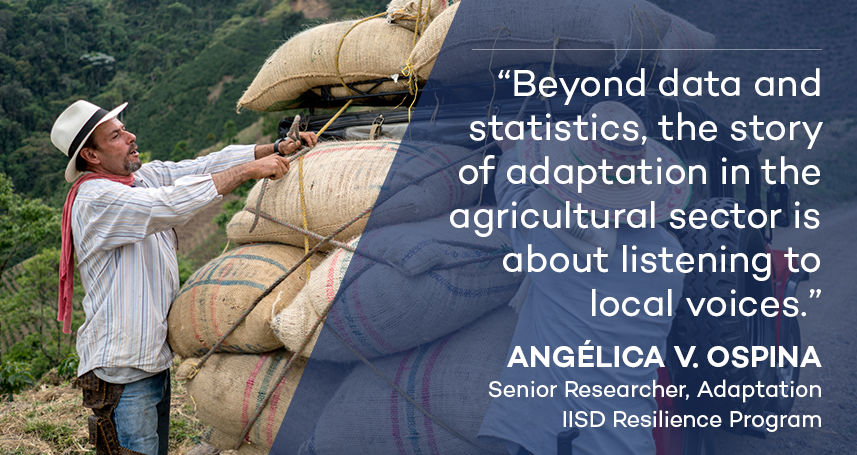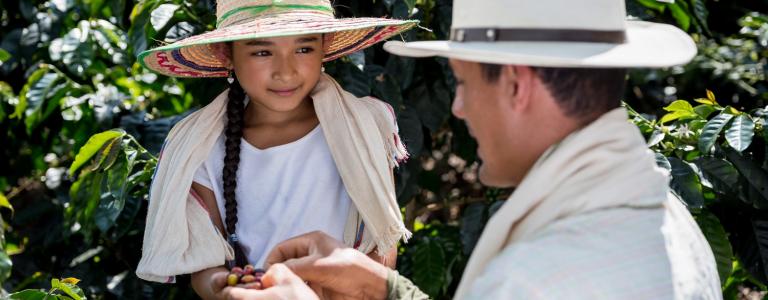Listening to Local Voices: What makes adaptation unique in the agriculture sector?
Achieving a more resilient agricultural sector is fundamental not only for a low-carbon future, but also to realize developmental goals related to the eradication of poverty and hunger, while learning how to better cope, adapt and transform in the face of climate change impacts.

We reached the upper part of the mountain on a cloudy afternoon, just as the rain had started to recede. Salvador Diaz, a Colombian coffee producer with a small plot of land, greeted us with a smile and a strong handshake. He had agreed to meet us to discuss the impacts of climate change and variability in the region, and to shed some light on the way in which small agricultural producers are adapting to changing conditions and growing uncertainty. His testimony, a local narrative of change, was crucial to understanding the complex environment within which adaptation takes place.
Very soon into the conversation, it became evident that the impacts of climate change and variability had had a deep impact on Mr. Diaz’s livelihood, and on the way in which he perceived his own vulnerability. As he explained:
“The weather is what influences our livelihood the most…70 per cent of this municipality depends on coffee, so climatic variations affect a lot of the coffee varieties, the occurrence of plagues and diseases…of every crop in general. The climate...has a direct impact. And it has changed. In the past, the crops were so good because we had 6 months of summer and 6 months of winter…Older people like me are witness of that.…Particularly in the last four years, the weather has been more disorganized…crazy.”
He talked about increasingly unpredictable “summer” and “winter” periods, and of “extreme conditions” during those cycles, which have direct effects on the farmer’s vulnerability:
“This area has been affected by climatic variability, of course…it's a mountainous area, so there are a lot of landslides in all the farms; even houses have been destroyed due to the winter.…There are several farms that have been isolated by the landslides for more than two months.…There is a caserio[1] that can not be reached by car or by motorbike…so the people have to go there walking or by horse”.
Feeling vulnerable and at risk in the face of climatic manifestations plays a role in shaping local behaviour, and can be key in the decision to undertake (or not) adaptive actions.

But are these perceptions, along with the urgency of the need to adapt to climate change, unique to the agricultural sector? The answer is: not necessarily. However, there are important factors that, when considered together, distinguish adaptive approaches in this sector.
What characterizes adaptation processes in the agricultural sector?
- A close adaptation-mitigation connection: While the sector is a major source of greenhouse gas emissions, its performance is crucial for ensuring food security and nutrition, and implementing innovative solutions to meet the needs of a growing population. Adaptation is closely linked to mitigation, and involves the analysis of co-benefits and collateral effects of adaptive actions.
- The need for broad multisectoral articulation: Agricultural adaptation requires the involvement of multiple sectors (e.g., forestry, health, water) in sectoral planning processes, along with the integration of multiple stakeholders involved in agricultural value chains (from input providers and producers, to markets).
- The importance of considering diverse types of producers: Agricultural adaptive approaches involve a distinct level of “granularity” in regards to the scale of implementation, as they involve the differential needs and priorities of diverse types of agricultural producers—in particular those of small-scale farmers that are at the forefront of climate change impacts.
- Balancing risk and timescales: Agricultural adaptation planning requires a clear understanding of short-, medium- and long-term risks, and a balance between responding to the needs of today (e.g., subsistence, in the case of small producers) and those of tomorrow (e.g., food security). The Food and Agriculture Organization (FAO) estimates that food production will need to be 60 per cent higher in 2050 than it was in 2006 to meet the demand of a larger population.
- The premise that “context matters”: Adaptive efforts in agriculture need to be firmly anchored in the context-specific needs of local livelihood systems, which differ between regions, countries and value chains.
- Building upon an ecosystem-based perspective: In the agricultural sector, adaptive actions need to be planned and implemented within the broader socioecological context, considering ecosystem services, local biodiversity and natural resource management.
- Combining new and traditional knowledge: Agricultural producers possess a wealth of Indigenous and traditional knowledge that need to be considered in the design of adaptive pathways, along with emerging scientific knowledge and technologies. Adaptation tools and methodologies should acknowledge and integrate both.
According to the FAO, climate-related disasters disproportionately affect food-insecure, poor people—over 75 per cent of whom derive their livelihoods from agriculture. But beyond data and statistics, the story of adaptation in the agricultural sector is about listening to local voices.
In the agricultural sector, adaptation has a tangible “human” component: it affects the individual producer, his or her family, and the livelihoods of millions of men and women around the globe. It involves both short- and long-term changes that need to be undertaken by the majority of the world’s rural population, precisely the most vulnerable to the impacts of climate change.
Achieving a more resilient agricultural sector is fundamental not only for a low-carbon future, but also to realize developmental goals related to the eradication of poverty and hunger, while learning how to better cope, adapt and transform in the face of climate change impacts.

[1] Caserio is a Spanish term that refers to small groups of houses located in rural areas, and constitute the smallest form of collective settlements.
You might also be interested in
Tree Planting for Climate Resilience in Freetown, Sierra Leone
This assessment presents the economic valuation of tree planting efforts in Freetown, Sierra Leone, including planting costs, added benefits, and avoided costs.
Sustainable Asset Valuation of Sherwan Hill Adventure Park in Abbottabad, Pakistan
This report analyzes the social, economic, and environmental benefits of the Sherwan Hill Adventure Park in Pakistan.
IISD's Best of 2024: Articles
As 2024 draws to a close, we revisit our most read IISD articles of the year.
Sustainable Asset Valuation of the Nutrition Sensitive Agriculture Capacity Strengthening Project in Ethiopia
This report analyzes the social, economic, and environmental outcomes of implementing agroforestry and climate-smart agriculture in Ethiopia.
